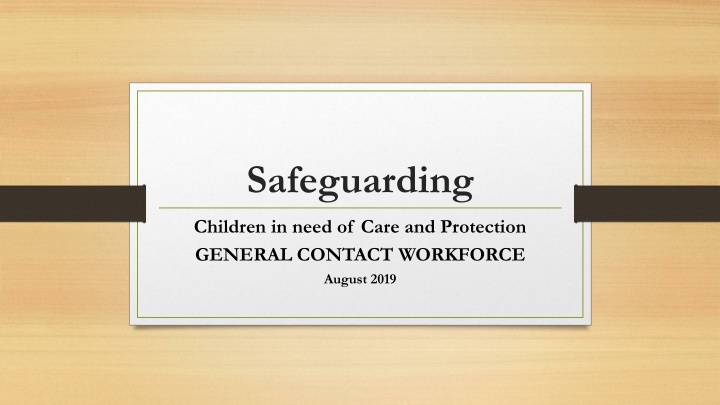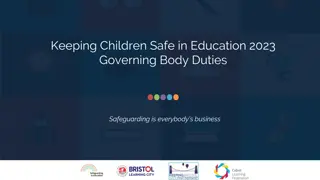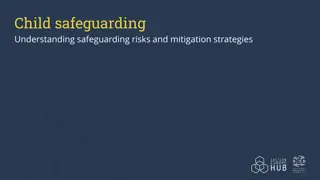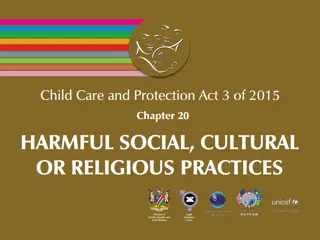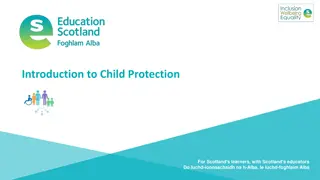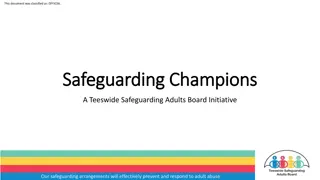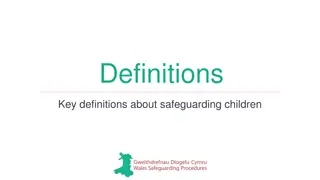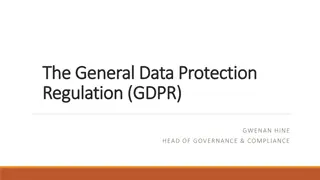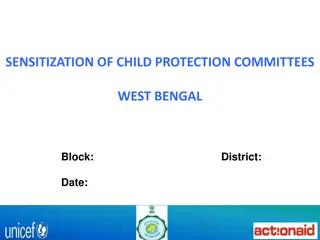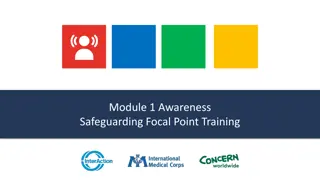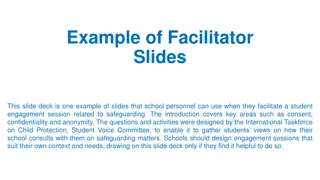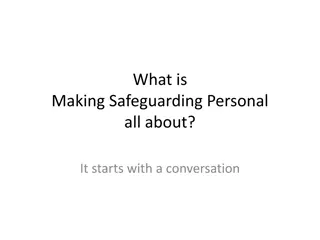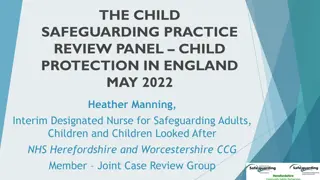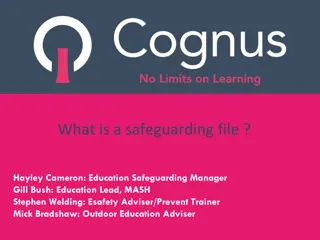Safeguarding Children: Understanding and Promoting Child Protection
This content focuses on the importance of safeguarding children in need of care and protection, covering topics like child abuse, children's rights, and corporate responsibility. It emphasizes the need for all children to grow up feeling loved, safe, and respected, while promoting initiatives such as "Getting it Right for Every Child" to ensure their well-being and development.
Download Presentation

Please find below an Image/Link to download the presentation.
The content on the website is provided AS IS for your information and personal use only. It may not be sold, licensed, or shared on other websites without obtaining consent from the author.If you encounter any issues during the download, it is possible that the publisher has removed the file from their server.
You are allowed to download the files provided on this website for personal or commercial use, subject to the condition that they are used lawfully. All files are the property of their respective owners.
The content on the website is provided AS IS for your information and personal use only. It may not be sold, licensed, or shared on other websites without obtaining consent from the author.
E N D
Presentation Transcript
Safeguarding Children in need of Care and Protection GENERAL CONTACT WORKFORCE August 2019
Aims Understanding the national landscape of child protection, children s rights and principles of GIRFEC Refreshing knowledge of child abuse, the range of associated risk factors and how to respond Reflect on our duties as corporate parents for care experienced
All children deserve to grow up loved, cared for and protected from harm. ARTICLE 19 I have the right to be protected from being hurt or badly treated
Education are duty bearers responsible for respecting, promoting & realising the rights of children
Getting it Right for Every Child supports children to grow up feeling loved, safe and respected. PROMOTE, SUPPORT AND SAFEGUARD WELLBEING FOR ALL CHILDREN Being protected from abuse, neglect and harm by others at home, school and community SAFE Having high standards of physical and mental health, access to healthcare, and support in learning to make healthy and safe choices Being supported in learning and in the development of skills, confidence and self-esteem at home, at school and in the community Having a nurturing place to live and learn HEALTHY ACHIEVING NURTURED Having opportunities for play, recreation and sport which contribute to healthy growth & development ACTIVE Having the opportunity, along with carers, to be heard and involved in personal decisions RESPECTED Having encouragement to play active and responsible roles in schools and communities RESPONSIBLE Having help to overcome social, educational, physical and economic inequalities INCLUDED
Understanding Child Abuse Abuse and neglect are forms of maltreatment of a child. Someone may abuse a child by inflicting, or by failing to act to prevent, significant harm. A child may be abused by someone known to them, or more rarely, a stranger.
How common is child abuse?
Categorising child abuse PHYSICAL ABUSE SEXUAL ABUSE NEGLECT EMOTIONAL ABUSE child is deliberately hurt as a result of hitting, burning, shaking etc Forcing or enticing a child to take part in sexual activities. Persistently failing to meet a child s basic physical and psychological needs. Deliberately trying to scare, humiliate or verbally abuse a child. Can cause cuts, bruises and broken bones Doesn t have to involve sexual violence, includes grooming, sexual exploitation and indecent images. Includes parental failure to provide adequate food, clothing or shelter. Failure to protect child from harm or to provide protection Passive emotional abuse occurs when an adult denies a child the love and care they need to be healthy and happy.
Potential Risk Factors Child trafficking Child sexual exploitation Online safety Parental mental health concerns Radicalisation Under-age sexual activity Female Genital Mutilation Forced Marriage Children and young people who are missing Children and young people who place themselves at risk Fabricated or induced illness Domestic Abuse Parental problematic alcohol and drug use Young people experiencing or affected by mental health problems Disability Children and young people who display harmful or problematic sexual behaviour Non-engaging families
What are the signs of child abuse? Some common signs that there may be something concerning happening in a child s life include: unexplained changes in behaviour or personality becoming withdrawn seeming anxious becoming uncharacteristically aggressive lacks social skills and has few friends, if any poor bond or relationship with a parent knowledge of adult issues inappropriate for their age running away or going missing always choosing to wear clothes which cover their body.
How do I respond to a disclosure ? If a child discloses to you your responsibility is to REPORT your concern to your identified CHILD PROTECTION OFFICER. Do Be accessible & receptive Listen carefully Take it seriously Reassure them they are right to tell Say what will happen next Make a factual record of what happened Share with CPO or depute DON T React strongly Jump to conclusions Speculate or accuse Agree to keep it a secret Ask leading questions Make promises you cannot keep Interrupt disclosure
WHAT HAPPENS NEXT? The Child Protection Co-ordinator will conduct an initial assessment of the information. It is important to gather the facts of the incident, what is alleged to have occurred, when, where, who else may have been present or witness. The Child Protection Co-ordinator will, if appropriate, contact Social Services following any disclosure or information suggesting a child has or is at risk of harm.
POSSIBLE DECISIONS Agree education only will follow up with the family may or not, lead to staged intervention Agree that social work only will follow up may, or not, lead to voluntary social work support for the family Agree to convene an Initial Referral Discussion with partners from police, social work and health to agree next steps Agree to joint investigation (Police and Social Work) Agree to an initial child protection case conference to consider registration
POSSIBLE OUTCOMES NO FURTHER ACTION VOLUNTARY SUPPORT CHILD PROTECTION REGISTER LOOKED AFTER Child s needs will continue to be met in nursery or school Social work will join the team around the child Child s name placed on the CP register, child protection plan created to address risk to child In some more serious cases the local authority will take some of the legal responsibility for a child s care and wellbeing. Children can be looked after at home or away from home
Care experienced children and young people on the child protection register have significantly lower school attendance rates than non looked after children are far more likely to face an exclusion than non looked after children are far more likely to leave school earlier than non looked after children generally achieve lower qualification levels than non looked after children are less likely to go in to a positive post school destination
Members of Stirlings Champions Board ask us to do better for them .
Care experienced FOSTER CARE LIVING WITHIN A FAMILY SETTING WHICH SHOULD PROVIDE STABILITY, EMOTIONAL SUPPORT AND A LOVING FAMILY ENVIRONMENT. KINSHIP CARE - WHEN A CHILD OR YOUNG PERSON IS LIVING WITH A RELATIVE I.E. AUNT, UNCLE, GRANDPARENT, STEP PARENT SIBLING ETC. RESIDENTIAL CARE GROUP LIVING WITH STAFF ALWAYS AVAILABLE HOUSES USUALLY IN A NORMAL STREET IN A COMMUNITY SETTING. SECURE CARE HIGHER LEVEL OF SUPPORT WHERE A YOUNG PERSON NEEDS TO BE KEPT MORE SAFE FROM EITHER THEMSELVES OR OTHERS. ADOPTION - A LEGAL PROCEEDING THAT CREATES A PARENT-CHILD RELATION BETWEEN PERSONS NOT RELATED BY BLOOD SOCIAL WORK INVOLVMENT WHILST STAY AT HOME - WHEN A YOUNG PERSON STILL STAYS AT HOME AND IS INVOLVED WITH SOCIAL WORK
Just because I am care experienced doesn t mean I cant have
IM STILL BREATHING I M STILL BREATHING I M STILL BREATHING I M STILL BREATHING
IM ALIVE I M ALIVE I M ALIVE I M ALIVE!!
YOUR CARE EXPERIENCE DOESN T DEFINE YOU!! we know it will be hard. At times you will feel very alone .. But you don t have to be WE ALL CARE
WE ALL DESERVE LOVE WE ALL DESERVE RESPECT WE SHOULDN T NEED TO ASK FOR IT NO ONE SHOULD BE MADE TO FEEL ANY DIFFERENT
IM STILL BREATHING I M STILL BREATHING I M STILL BREATHING I M STILL BREATHING
IM ALIVE I M ALIVE I M ALIVE I M ALIVE!!
WE ALL HAVE RIGHTS.. THE RIGHT TO HAVE YOUR BEST INTERESTS AS THE MOST IMPORTANT CONSIDERATIONS IN ALL DECISIONS INCLUDING YOU HEALTH, EDUCATION, CARE AND FUTURE THE RIGHT TO BE PROTECTED FROM HARM THE RIGHT NOT TO BE DISCRIMATED AGAINST THE RIGHT TO GOOD STANDARD OF CARE THE RIGHT TO BE HEARD
IM STILL BREATHING I M STILL BREATHING I M STILL BREATHING I M STILL BREATHING
IM ALIVE I M ALIVE I M ALIVE I M ALIVE!!
WE ARE CARE EXPERIENCED WE HAVE SURVIVED AND WE ARE ALIVE!
Safeguarding is a much wider concept than child protection focussing on safety, wellbeing and dignity of all children and young people. Safeguarding permeates many features of the education experience including leadership, values, vision, the curriculum, learning & teaching , positive relationships and building learner resilience.
